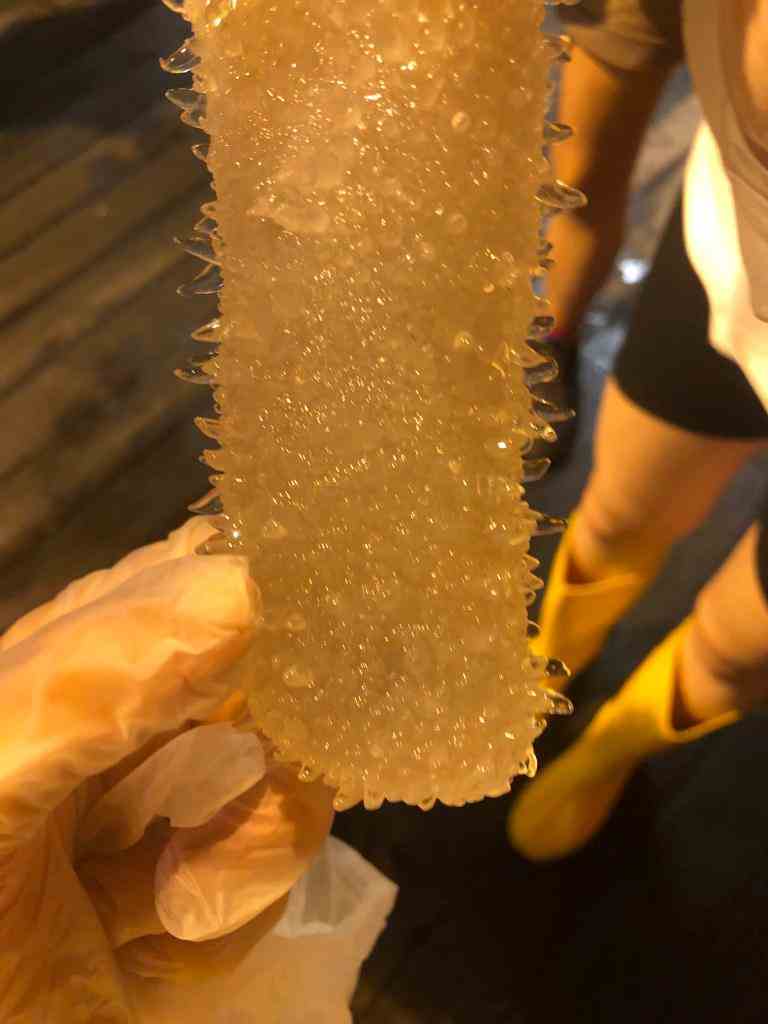Early on in our cruise, during one of our first night-time sampling stations between Ecuador and the Galapagos Islands, we were mesmerised by the most ghostly sight – pale, hollow floating tubes of all sizes suspended in the water and drifting in the strong equatorial currents. After some debate and with a little research we concluded that these creatures were Pyrosomes – enigmatic floating zooid colonies. We couldn’t be blamed for initially guessing “fish ghosts,” since their bioluminescent appearance and aimless drifting really did make them look supernatural. Hundreds of these colonies were floating by, ranging in size from a few centimetres to over a meter long, resembling elongated thimbles or hollow tubes that were closed at one end.

Despite their abundance in the ocean, Pyrosomes remain somewhat mysterious. A study of Pyrosomes in the Atlantic Ocean conducted by a team in GEOMAR lead by Vanessa Stenvers in 2018-2019 revealed that Pyrosomes are in fact of great importance to the marine ecosystem, contributing a significant portion to the carbon cycle and supporting the ecosystem in some surprising ways. In their press release, Stenvers tells us that Pyrosomes “form an important biological substrate in the water column that other animals use for settlement, shelter and/or as a food source.” One of their discoveries of this Atlantic variety was that small (yet undescribed) amphipods actually make little holes in the Pyrosome structures to make room for themselves to shelter from disturbances. Additionally, even though their motion appeared to us to be dictated by the currents, Pyrosomes actually migrate up and down in the water column in day-night cycles so that they can feed in the surface layers at night.
As we marvelled at these floating enigmas, we were lucky enough to get to see one up close. As our trace-metal clean CTD surfaced, one of the colonies was (unfortunately for the inhabitants) caught on the rosette frame. We acted quickly, and our brave colleague Polina came to the rescue, gently removing it from the frame with clean gloves on, and after we took a few quick photos and looked up close at the intricate framework, she returned it to the ocean within 60 seconds. Even though our interaction was short, it was exciting to see this enigmatic phenomenon up close and personal, and motivated us to continue our work in understanding the biogeochemical cycling in this part of the ocean, which will ultimately determine the fate of creatures such as Pyrosomes in a changing environment.
by Edel Mary O’Sullivan
Press Release GEOMAR: https://www.geomar.de/en/news/article/pyrosomes-enigmatic-marine-inhabitants-with-an-important-role-in-the-cabo-verde-ecosystem
Citation: Stenvers, V.I., H. Hauss, K. J. Osborn, P. Neitzel, V. Merten, S. Scheer, B. H. Robison, R. Freitas, and H.-J.T. Hoving, 2021: Distribution, associations and role in the biological carbon pump of Pyrosoma atlanticum (Tunicata, Thaliacea) off Cabo Verde, NE Atlantic. Scientific Reports, doi:https://doi.org/10.1038/s41598-021-88208-5